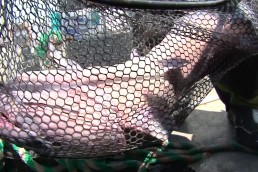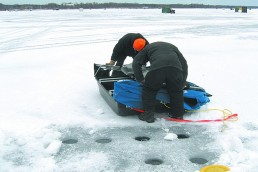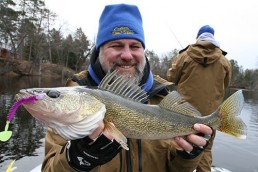Speaking the Language of Fish with your Jig
SHARE THIS POST
In our last episode, ice fishing legend Dave Genz was talking about the proven magic that happens when you fish a jig designed to ride horizontally in the water on fresh line, using a good jigging rod, with the knot positioned to keep the jig horizontal. It’s known as the “Genz Pound,” or just pounding, and it is the classic presentation that rules over all others in modern ice fishing.
If you did nothing but rotate the knot––all the way––in the direction of the hook point, and became good at rapidly vibrating your wrist to keep your jig looking alive down there, you would have one good day after another out there on the ice.
But let’s say for a second that you want to know more. That you want to know what Genz does when the classic pounding presentation doesn’t bring as many bites as it usually does.
“To start out the day,” says Dave, “I think about what spots the fish are probably in, and go to one of those spots and drill some holes. Then we fish those holes, quickly, aggressively, looking for fish that are ready to bite. Look for fish on your electronics, and drop a bait down all of them, to see if you can pull fish in, even if you don’t see anything right away.
“You use what happens at that first set of holes to decide where you’re going to drill your next set of holes. I start off pounding it, and that usually works. When the fish get harder to catch, we move on and drill more new holes. But sometimes the fish don’t bite right away. They want something different, so you have to give them something different.”
Pacing the pound
Any time fish don’t pounce on a pounded jig, Genz makes a mental note of that and begins to experiment with the pace of the pound. It’s something he has done for so long that it’s become a muscle memory, something he hardly thinks about. He just does it.
“Rather than tying on a new jig, or thinking about changing colors,” says Dave, “my first reaction is to experiment with the cadence. You can slow it down, which also lessens the vibrations being sent out by the jig. It changes what your presentation looks like, and feels like, to the fish. It has to feel right to them.”
Listening to Genz and his friends talk about what the fish wanted at the end of a day on the ice is fascinating. And carefully watching Genz work his way through various cadence routines can be instructional. Pat Smith, a deadly ice fisherman himself, jokes about how Genz would probably take out a restraining order against him if he knew how much time he spends just watching how Dave experiments with this important speed factor.
“What you want to avoid,” says Genz, “is sitting there too long experimenting with presentation. The Winter Fishing System is built around the idea that you should stay mobile and go find fish that are ready to bite. If the fish don’t bite, go to a new spot and drill more holes. Don’t give up on the idea that there are biters somewhere. But the longer you go into the day without catching fish, the more you should be changing how you’re working the bait. It can make a difference when the bite is tough.”
Dial in the knot
In addition to varying the pace of the cadence while presenting a jig, Genz has also begun to experiment with moving the position of the knot to different angles on the eyelet.
“When you bring the knot all the way around on the eye, toward the hook point,” he says, “that gives you the most vibration. That’s the position I use most of the time. But now I’m working on what happens when you dial the knot to different positions on the eye.”
Maximizing vibration, keeping that jig fishing in a horizontal posture, creating that buckin’ bronco kick to the hook end (which causes the maggots, plastic, or other add-ons to pulse around enticingly) will produce really well on most days, as we’ve already said. Attention to detail in this regard, according to Genz, is one sign of an accomplished angler.
“Rotating the knot on the jig eye has to become a habit,” stresses Genz. “Last winter, watching my brother, Jerry, who’s 80 years old, he automatically rotates the knot each time, before putting the line down the hole. Even though he’s one of the oldest guys out there, many times he has the best quality fish at the end of the day.”
Are you enjoying this post?
You can be among the first to get the latest info on where to go, what to use and how to use it!
But, as Genz points out, there are times when fish don’t bite well on the go-to presentation. That’s when it’s time to experiment. In addition to changing up the speed and style of his cadence, Dave has been playing with the position of the knot to alter the motion and vibration signature, to look for what triggers fish on any given day.
“I think of the jig eyelet as the upper half of a wheel,” says Genz, “and I move the knot to different positions on the wheel to see what it does to the presentation, and how fish react to it. I’m fairly early in my time of doing this, so I’ll have more to report as this winter goes on, but it’s an interesting variable to test.”
If you look at the entire eyelet and think of it as that “half wheel,” on which you can place the knot at different positions, it’s easy to imagine the possibilities. When the knot is all the way toward the hook point, that forces the jig into more of a horizontal swimming attitude, and produces the maximum vibration with each “kick” as you rapidly move your wrist and the rod moves up and down.
At the other end of the “wheel” the jig assumes a vertical posture. This is the position it takes every time you catch a fish or snag on something and have to pull free. While Genz stands by the notion that rotating the knot all the way toward the hook point will catch you more fish on most days, there are times when a vertical jig carries the day.
“Sometimes, fish like the lure rising up off the bottom, looking like it’s swimming to the surface,” explains Genz. “This is something fish have seen, when insects emerge and rise up. When they want it rising, having the jig hang more vertically is important.”
To test whether this approach will be effective, Genz moves the knot away from the hook point, so the jig hangs vertically. “I rotate that knot around,” he says, “drop the jig to the bottom, pound it into the bottom a few times, and start rising it up with a swimming, kicking motion. If they want that, they’ll bite it. It’s another method to try when fish are down there and you’re struggling to get them to bite.”
Between these two extremes, the “wheel” offers other knot positions to experiment with.
“So many people are quick to change the color of the lure, or tie on a different type of bait,” says Genz. “That’s not wrong to do, but by altering how you’re presenting the jig you already have on there, you can do a lot of testing before you change color or tie on a different bait.
“Besides doing this, make sure your plastics are on there straight, so the jig can work properly, and if you’re using live bait, make sure it’s fresh. Make sure there’s fresh juice coming out of those maggots, before you start thinking about changing jig colors.”
Every day of fishing is a big experiment, where you are asking the fish what they want by showing them things you think they might want. And now you know a lot more about what Dave Genz does, in addition to drilling more holes. “Some of those little things you can try,” he says, “make a big difference on some days.”
Here’s to your winter of experimentation with cadence, pounding styles, and knot positions.
Note: Dave Genz, known as Mr. Ice Fishing, was the primary driver of the modern ice fishing revolution. He has been enshrined in the National Fresh Water Fishing Hall of Fame and Minnesota Fishing Hall of Fame for his contributions to the sport. For more fishing tips and to order his new info-packed book, Ice Revolution, go to davegenz.com.
MWO
SHARE THIS POST
Did you enjoy this post?
You can be among the first to get the latest info on where to go, what to use and how to use it!
Mark Strand
MidWest Outdoors editorial director Mark Strand is a graduate of University of Minnesota School of Journalism with a minor in Fisheries & Wildlife Science. He has written for nearly every outdoor magazine over the past 41 years, and has written or co-written 14 books. In addition to writing and photography, Strand produces the MidWest Outdoors Podcast, and contributes to MWO digital properties. He is an outdoor generalist who loves hunting and fishing of all types. In 2018 Strand was elected to the Minnesota Fishing Hall of Fame.



